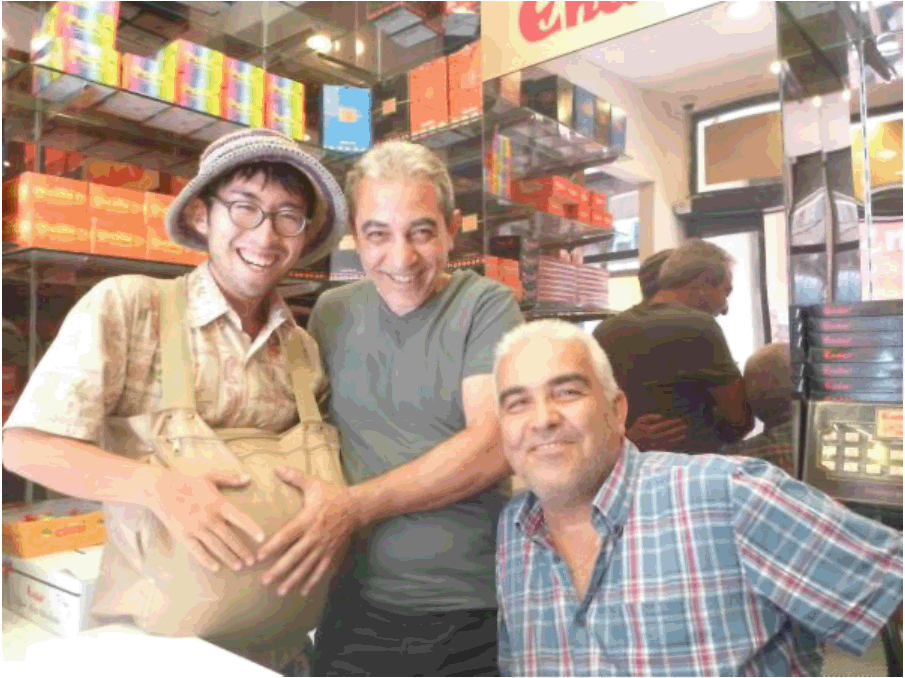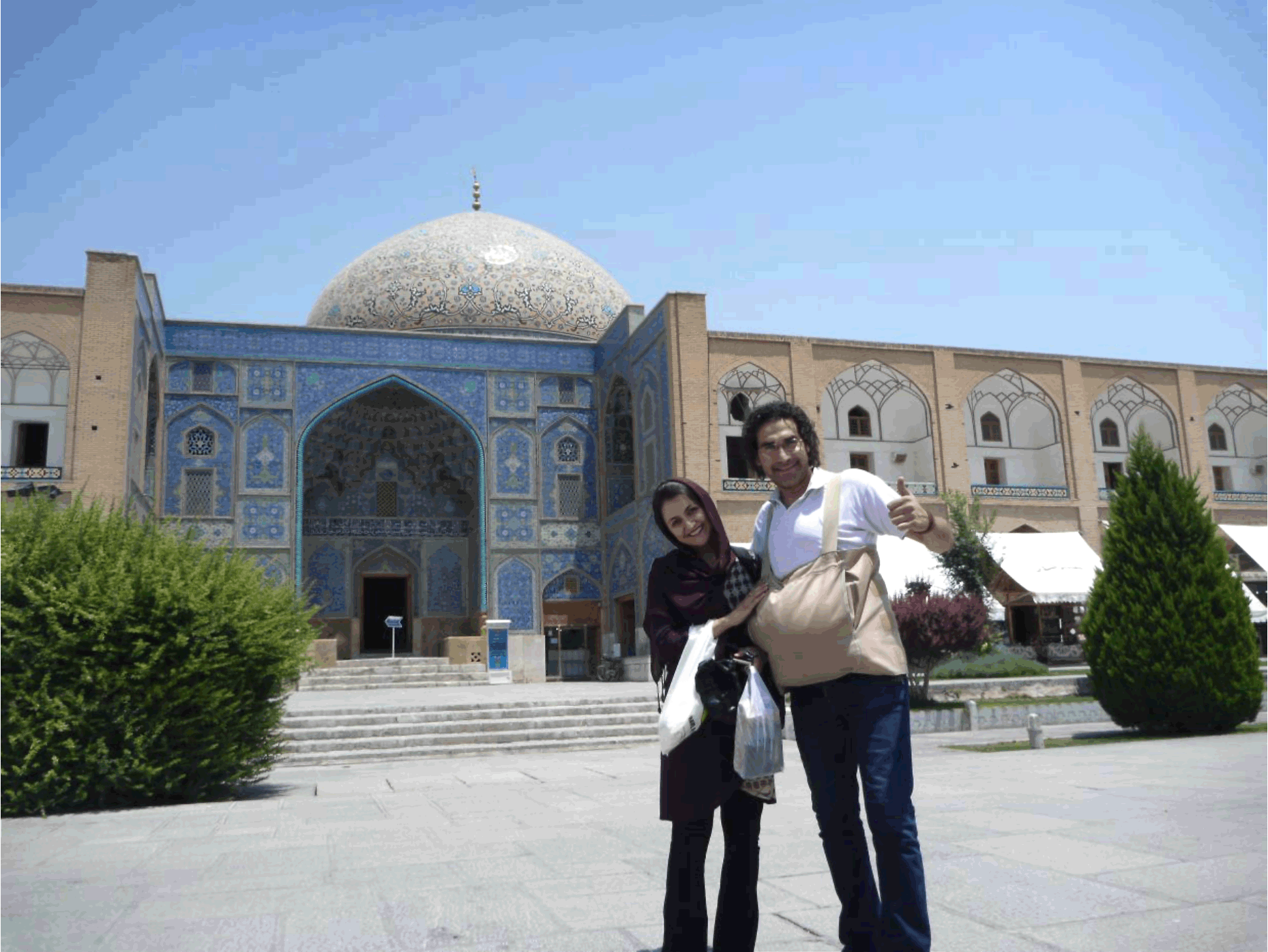The Author with the Pregnancy Simulator and a Participant in Istanbul, Turkey.

Kota Hakoyama1
doi: http://dx.doi.org/10.5195/ijms.2017.224
Volume 5, Number 2: 87-89
Received 30 01 2017: Accepted 13 06 2017
After completing the first three years of basic medicine courses at my medical school, I was determined to take a leave of absence and travel around the world as a ‘pregnant’ man (Figure 1). Of course, I was not actually pregnant myself; my plan was to hike across various countries wearing a pregnancy simulator, aiming to encourage males to be more sympathetic to mothers. The pregnancy simulator, filled with 10 kg of water, simulates the weight of a pregnant mother‘s belly. That is, by wearing it, one can experience one of the hardships that pregnant women face during their last month of pregnancy.
Figure 1.The Author with the Pregnancy Simulator and a Participant in Istanbul, Turkey.

After earning the travel budget by working part-time and using a crowd-funding service, I started the journey from my home country, Japan, in February 2015. In the 468 days that followed, I traveled to 43 countries spanning Asia, the Middle East, Europe, Africa and Latin America. I used local buses and trains to travel inland and stayed in budget accommodation to cut back on spending. Every three days in each country, I hiked with my pregnancy simulator and asked local males to wear it. I considered this project to be of utmost importance for peer education and saw it as indispensable for realizing gender equality.1
When I was wearing the simulator over my belly, I feared that someone might mistake me for a suicide bomber. To avoid trouble, I knew that I needed to explain my project with sufficient clarity. Therefore, I first made detailed instructions in each local language, cooperating with bilingual people who could use English. After finishing preparations, I went out into the cities and talked with local people. I thought this would be better as I figured men would prefer to gather in informal settings for social interaction.2
Upon beginning this adventure, I would introduce the project‘s concept and place the simulator on anyone who would accept my invitation to participate. I generally asked participants to do three things; to walk around or climb stairs, to pick up something from the floor, and to lie down. I wanted participants to experience a piece of daily life with the simulator and feel the difference for themselves. After that, I spread my message, saying ‘please take care of your baby, your wife and your mother. Respect women and be a good father!’
You may wonder why I thought about starting this strange project. I am especially interested in maternal and child health, partly because of my respect for my mother. After my parents divorced, she worked as a high school teacher to bring up her three children, including myself. I vividly remember her words, ‘we don‘t have a lot of money, but I will always pay whatever you need to study.’ Thanks to her generosity, I was able to successfully enter medical school and chase my dream.
The country I achieved the most in during this project was Iran, which I was told is famous for the hospitality of its people. I was determined to visit but remained a bit worried after some friends advised me not to go there because of concerns about unrest in the region. However, when I visited, I found that my anxiety was completely ungrounded. Everyone listened to my story eagerly and said ‘the Quran, the teaching of Islam, says you must try to best take care of the mothers. From this viewpoint, your project is perfect!’ (Figure 2). Muslim people said similar statements to me not only in Iran but also in Morocco, Azerbaijan and Sudan. Surprisingly, only Muslim people mentioned religion during the pregnancy simulation, and I realized that I had been judging the people of this region based on stereotypes I had heard that ‘the Middle East is dangerous’. Whenever I became discouraged, I often recalled their kind words to give me the strength to continue my project.
Figure 2.A Participant (Wearing the Pregnancy Simulator) and his Wife in Isfahan, Iran.

In total, 1070 people tried the pregnancy simulator throughout my project. Generally, 1 in 3 men accepted my invitation to wear the simulator. Most people refused, saying things like ‘I don‘t have time,’ or ‘I have a stomachache.’ On the other hand, there were excellent reactions from those who tried the simulator. At first, most men seemed shy and were not willing to wear the simulator. But once they did, they smiled, and many took selfies with their smartphones. Outside Europe, the pregnancy simulator was largely unknown beforehand to the general public. Particularly in the developing countries of Asia and Africa, I found that many people were surprised to see and hear about such an idea, and quite a number enjoyed it. I was delighted to have this opportunity to communicate with them using the simulator.
Throughout this experience, it was made obvious to me that I was just one person in this huge world, and as such could not change peoples’ perceptions easily. However, I am certain that I was the first person to travel around the world with a pregnancy simulator aiming to spread awareness. The days of trial and error I experienced in the project made me stronger, and I will continue to study and take further strides towards more accessible public health campaigns in the future. I will not give up on making the world better for mothers.
I wish to thank Dr. Masahiro Kami, Dr. Tetsuya Tanimoto, and Ms. Claire Leppold for their advice on writing this essay.
The Author has no funding or conflicts of interest to disclose.
Conception and design the work/idea, Collect data/obtaining results, Analysis and interpretation of data, Write the manuscript, Critical revision of the manuscript, Approval of the final version: KH.
Watson E. Gender equality is your issue too. Speech by UN Women Goodwill Ambassador Emma Watson at a Special Event for the HeForShe Campaign, United Nations Headquarters, New York. 2014; 20.
Nasreen HE, Leppard M, Al Mamun M, Billah M, Mistry SK, Rahman M, . Men‘s knowledge and awareness of maternal, neonatal and child health care in rural Bangladesh: a comparative cross sectional study. Reprod Health. 2012 Sep 3:9:18.
Kota Hakoyama, 1 School of Medicine, Hokkaido University, Sapporo, Japan
About the Author: Kota Hakoyama is a fourth-year medical student of a six-year program at Hokkaido University in Sapporo, Japan.
Correspondence: Kota Hakoyama. Address: School of Medicine, Hokkaido University, Sapporo, Japan. E-mail: kota0822mt.box@gmail.com
Cite as: Hakoyama K. The Travels of a Volunteer with a Pregnancy Simulator. Int J Med Students. 2017 May-Aug;5(2):87-89.
Copyright © 2017 Kota Hakoyama
International Journal of Medical Students, VOLUME 5, NUMBER 2, August 2017